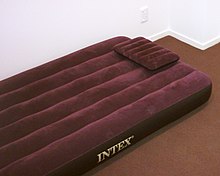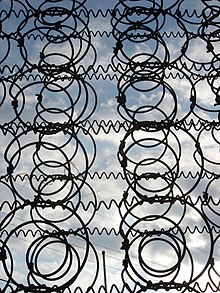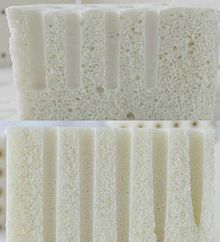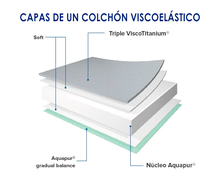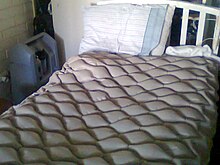Mattress
The mattress is a padded and flexible piece that is placed on the bed and used for sleeping. The wool-filled mattress arrived in Europe after the Crusades, when Europeans adopted the Arab custom of sleeping on cushions. The name derives from the Latin culcĭta, quilt, bed covering.
History
Formerly, mattresses consisted of a cover filled with organic materials such as straw, wool, leaves, etc. which were nests for small insects (mites, fleas, bedbugs) so they had to be ventilated and aerated periodically. Wool mattresses were popular in Europe well into the 20th century. In some countries, there was the figure of the mattress maker who was a professional who traveled from town to town airing, stuffing and fluffing up wool mattresses.
In the 16th century the air mattress was launched in France and enjoyed a limited period of success, as did than in the 17th century in London. At the beginning of the XVII century, the first spring mattresses appeared in England. The problem is that, as they are cylindrical springs, they were not compressed, but rather they fell to the front and sides.
In the mid-1850s, conical springs began to be manufactured, still by hand, to facilitate their vertical compression. One of the most popular mattresses in America was launched in 1925 by the manufacturer Zalmon Simmons and was called the Beautyrest.
Mattress size
Traditional measures in the US and UK
- King or 2 and a half (193 x 203 cm)
- California King (182 x 213 cm)
- Queen or 2 beds (152 x 203 cm)
- Full or square and medium (137 x 191 cm)
- Single or square (97 x 191 cm)
- Small single or 3/4 square, only in United Kingdom (76 x 190 cm)
Traditional measures in Latin America
- King or 3 squares (200 x 200 cm)
- Queen or 2 and a half (160 x 200 cm)
- Matrimonial or 2 beds (140 x 190 cm)
- Full or square and medium (120 x 190 cm)
- One square (100 x 190 cm)
Traditional measures in Argentina
- Super king size (200 x 200 cm)
- King size (180 x 200 cm)
- Queen size (160 x 200 cm)
- Two and a half squares (140x190)
- Two squares (130 x 190 cm)
- Square and medium (100 x 190 cm)
- One square (80 x 190 cm)
Traditional measures in Chile
- Super King or 3 squares (width: 200; long:200 cm)
- King or 2 and a half squares (width: 180 or 190 cm; length: 200 cm)
- Matrimonial or 2 squares (width: 150 or 160 cm; long: 190 or 200 cm)
- Full (Width:135 cm; length: 190 or 200 cm)
- Square and medium (width: 100 or 105 cm; length: 190 or 200 cm)
- A square (width: 80 or 90 cm; length: 190 or 200 cm)
- kindergarten (width: 70 cm; length: 140 cm)
Traditional measures in Spain
- Double width (200 x 200 cm)
- Large marriage (150 x 190 cm or 200 cm)
- Marriage (135 x 190 cm or 200 cm)
- Canon (110 x 190 cm or 200 cm)
- Body and medium (105 x 190 cm or 200 cm)
- From a body or individual (90 x 190 cm or 200 cm)
Types of mattresses
Wool mattress
Very popular in Latin American Hispanic cultures and colonies from the time of the Crusades until well into the XX century, the wool mattress was the most common alternative for the popular classes.
The manufacture of this mattress consisted of first forming the covers with a thick textile material and then subdividing it into longitudinal chambers of around 30 cm in diameter. The wool was washed, pickled and classified before introducing it to each of the chambers. The wool was put under pressure and by force of the arm through each chamber until a mattress with a relatively uniform surface was achieved, very heavy, with good thermal quality but not very resilient. This type of mattresses disappeared in the late 1970s in rural Latin American communities; although there are still isolated communities that do so.
It has the disadvantage that it is highly allergenic, so it should not be used by those with asthma and/or allergies.
Feather mattress
Still highly appreciated and current, mattresses filled with bird feathers are highly desired for their special resilience or flexoelastic qualities, especially goose (or swan) feather mattresses and duck feather mattresses. Goose feathers provide unique flexoelastic qualities due to their arched shape, so mattresses have thermal properties that make them highly appreciated in cold climates.
Goose feathers are by-products of bird slaughterhouses, and in some countries they are raised as poultry to await the natural molt, when they are harvested. They are high cost mattresses therefore. Chicken feather-based mattresses do not have good flexoelastic or thermal qualities, which is why they are not currently used.
Air mattress
They are modern mattresses, currently in widespread use for campsites. They are literally rectangular bags that are filled with air. Flexibility or hardness is achieved by removing or adding air to the interior. If they are completely filled with air to the limit, the mattresses are somewhat hard and somewhat resilient, but they are very light and easy to store once empty.
Mattress made of vegetable materials
Widely used in the cultures of Japan, China and Korea, they are very thin mattresses made of natural fibers such as tatami, reeds and rice. They have no resilience and provide little flexoelastic quality to the body at rest; however, it seems that these cultures have lower rates of spinal deformations due to its rigidity than Western ones.
Spring mattress
It is the most common. Its core consists of a casing composed of springs made of iron wire about two millimeters thick. These are fixed at the top and bottom to a steel contour rod. The casing is usually protected by a layer of fibers to which a polyurethane foam sheet can be added. Foam corner pieces are inserted into its corners to give it greater consistency.
The lids are placed on it. The top is made of a fabric of various materials and designs (damask, piqué, etc.) that is padded with one or more sheets of polyurethane foam or, more recently, latex. Ultimately, the firmness of the mattress will depend on the height of the shell, as well as the number and density of shock absorbing plates it contains. The side platbands are also padded in the same fabric and are sewn to the tops by means of weather stripping. In the platbands, holes are made or ventilation valves are inserted that allow the circulation of air during the night.
The mattress can be reinforced by adding material (fiber blanket, foam sheet, etc.) in certain areas. This is done occasionally in the lumbar third and more rarely in the cervical and foot area.
There are different variants depending on the configuration of the springs:
- Biconic springs or Bonell. The docks have a double cone shape (i.e., they narrow through the center) that best adapt to the weight of the different parts of the body. It's the Bonell type housing.
- ]Cylindrical or conquered springs. The docks are cylinder-shaped. They usually go constrained to avoid annoying sounds due to friction.
- Compact housing. It is made with iron wire that crosses the structure in the form of zigzag. Throughout the perimeter, romboidal springs are placed, which gives greater firmness and stiffness to the mattress.
Water mattress
The use of the water mattress is very little extended but it is offered by different manufacturers, influencing its great weight of 1 to 2 tons as a factor against it. The core consists of a set of watertight modules filled with water. The first mattress of water appeared as early as 3600 BC. C. in Persia, formed by skins filled with water.
Latex mattress
It consists of a block of latex wrapped in a padded cover. This block is obtained by skimming the liquid obtained from the Hevea brasiliensis tree, abundant in Malaysia.
The block takes the shape of the mold of different manufacturers. Generally, it has holes that allow air circulation and that are distributed unevenly on the surface to create different comfort zones. Latex adapts to the body more uniformly than springs, which is why it is considered an evolution of this type of mattress. Another use of latex is as a replacement for the polyurethane sheets of traditional mattresses, thus providing a mixed rest formula. The adaptability of latex makes the mattresses ideal for combining with folding bed bases or electric beds.
There are several types of latex, on which the quality of the mattress depends.
- Synthetic: is obtained from a synthetic latex formulation.
- Mix: goes from 20% latex, to 50% of it, combined with foams. They are usually less likely to develop moisture and are less heavy than those of natural latex.
- Natural: it is considered natural when in 85 % it is latex and the rest foams or other types of materials, usually additives used for the transport to Europe of the liquid obtained in Malaysia.
It is very important to take into account that the legislation in Spain allows the labeling of the first two types of latex as 100% latex, which is usually misleading, since these are products that are mostly synthetic.
In the case of natural latex, which is generally more expensive, it can be labeled as such when it exceeds 85% natural material. The main drawbacks are that the latex must be aired at least twice a week and if the percentage of natural latex is very high, the mattress is too heavy to move, it degrades before the synthetic one and it is more likely to develop mold. This is the main reason why manufacturers recommend the use of latex mattresses with bed bases that allow ventilation, such as box springs, while upholstered bases or box springs are discouraged.
Foam mattress
It is made up of a block of polyurethane foam of variable density (40kg, 50kg, etc.) covered in a cloth, generally cotton.
Memory foam mattress
The viscoelastic material (flexible polyurethane) was developed by NASA with unique and innovative properties to relieve pressure from the body. This type of synthetic material was born as a direct result of the space program in the 1960s, although it was in the early 1990s when researchers managed to incorporate it into domestic use. The viscoelastic material (also called viscoelastic , viscoelastic , viscolastic , viscoelástica , etc.) incorporated into articles of the rest, at first it was used mainly in hospitals, but in recent years its sale has become so widespread that this type of mattress is now found in many homes.
Among the properties of the viscoelastic material, its great adaptability and its medium degree of firmness stand out.
Viscoelastic foam mattresses are made up of several parts of variable density made with a foam called high resilience or HR (High Resilence), from 18 kg/ m³ in the most basic ranges and reaches up to 90 kg/m³, depending on the firmness desired by the sleeper. This density determines whether the mattress is softer or harder. For this reason, a medium density is more suitable than one that is very soft or too hard. In the first case, it can result in insufficient support for the body and healthy alignment of the spine and, in the second case, the hardness of the material can make the weightlessness, typical of this material, disappear., in addition to the fact that breathability is almost zero, since this high density does not allow the pore to be barely open for air to circulate.
Mattresses with viscoelastic foam have the particularity that they adapt very well to the contour of the body, avoiding back pain. They are used more frequently in the care of adults or people with a physical disability that does not allow them to move and must remain lying down for long periods of time.
Mattress
It is a small mattress. The mat is lower than the mattress (about 10 cm high), they can be one or two people.
The manufacturing process is similar to that of a mattress, but a lower shell is used and the number of components used is saved: foam sheets, aeration valves, etc. Like these, it can be made of foam, springs, latex, etc.
It is considered a lower-middle range product, since it is cheaper than a mattress. It is marketed for youth segments and is used in hostels, camps, campsites, etc. It is also indicated to place at the bottom of the trundle beds.
The inflatable plastic mattress used to lie on beaches, swimming pools, etc. is also called a mat. It is used mainly by children and young people as entertainment during the vacation period. There is also the sports mat, which is used mainly for gym classes in schools.
In several countries, especially in Argentina, what in Spain are called insulating mats are called mats.
Special mattresses
Depending on their destination, some mattresses require special manufacturing characteristics, either due to legislative imposition or due to their use requirements. Thus, those destined for prisons or public transport (sleeping cars) are made with fireproof materials. For their part, those used by the marina are given an anti-oxidation treatment on the docks.
Mattresses for babies
The memory foam mattress is not suitable for the rest of our babies, since the density of this type of foam (which is activated by weight/temperature) does not mold to the little body or eliminate pressure points on the head, shoulders and hips, which would become too rigid a surface for our babies. Also, since it is a type of foam that has less breathability, you run the risk of breathing problems, including sudden death.
This type of mattress must have a special waterproofing treatment and be stain-proof in order to avoid incidents, since babies usually do not control their sphincters until around 18 months (although this is not a fixed pattern).
Sanitary and anti-decubitus mattresses
Mattresses that are made of adaptable materials that do not put pressure on the body are known as anti-decubitus, thus preventing the appearance of bedsores in the sleeper. These types of mattresses are specially designed for people whose health needs require them to remain at rest for a long time, and due to the rubbing that the rest equipment exerts on certain points of the body, the appearance of sores or bedsores can occur.
At first these mattresses were used in hospitals and geriatric centers, but today they can be purchased privately, since the advantages of the new adaptation materials have expanded their use and marketing. These types of mattresses are normally combined with special articulated bed bases that facilitate the mobility of the patient in their rest equipment, as well as the tasks of the caregivers.
There are different types of anti-decubitus mattresses depending on their composition: mattresses with adaptable foams such as viscoelastic material, latex, HR foam or air.
Advantages and disadvantages of new materials
One of the basic needs of the human body is rest, since the deeper and uninterrupted the rest, the greater the restorative and renewing effect of sleep. There are several causes that prevent getting a quality sleep by interrupting the REM phase (Rapid Eye Movement) of sleep. One of them is the pressure exerted by the resting surface on our body, to the point of forcing us to change position over and over again. This movement causes a micro-awakening that makes us come out of the deep sleep phase.
The adaptability of some materials (viscoelastic) eliminates the pressure of the resting surface on the body, allowing you to stay longer in the optimal phase of rest. However, it must be taken into account that sleep, according to specialists, is an active phase and requires a series of "natural" during the same; For this reason, it is convenient to avoid rest surfaces that cause the feeling of boxing in, since the natural need for movement of the body, when it is impeded, also causes the sudden abandonment of the REM phase of sleep. Rest specialists have verified that the optimal mattress to rest should be neither hard nor soft.
Modern, good-quality viscoelastic material is made up of open cells and allows air to circulate freely, which is why molded or closed-cell (viscoelastic) can sometimes increase the sensation of heat in the bed. This premise is usually more accurate in basic range products that are advertised as viscoelastic material but that do not have the necessary treatments so that they adapt healthily to the sleeper. In the case of the foamed material, also called open cell, it has a honeycomb-shaped structure, which guarantees the absence of heat in the mattress; In addition, to guarantee maximum hygiene while sleeping, and thanks to technological advances in research and development, the materials include anti-mite, antibacterial and antifungal treatments, useful throughout the life of the mattress.
Distribution
Mattresses are sold mainly in specialized stores, furniture stores and supermarkets, although the growing trend is to buy online, since the consumer has a trial period that gives them the confidence to try it for several days and verify so it really is fit for your rest.
The main distribution channel for mattresses are furniture stores and specialized web pages, where the first purchase of bedroom furniture is made, together with the mattress and, generally, making a basic investment as it is a complement. Then there are replacement sales when only the mattress is changed, which is produced in the rest of the establishments investing more in health and comfort. The market is divided equally between the first purchase and the replacement. As for the specialized trade, the traditional mattresses have given way to high-end establishments where electric beds, bedding, and even home furnishings are found. Other sales channels are hotels and institutions, which groups hospitals, prisons and the armed forces.
Maintenance
Tipping and turning: It is recommended to turn and turn the mattress according to the manufacturer's instructions. In a generic way, the recommendation is 4 times a year, one for each change of season to make it easier to remember. The flips should not only be from one side of the mattress to the other, but you also have to make turns between the foot and head areas, in this way we obtain:
- Side 1 head to foot
- Side 1 feet to head
- Side 2 from head to foot
- Side 2 feet to head
In this way we achieve that the pressure forces that our body exerts on it are distributed in a balanced way and we avoid that there are more sunken areas than others, which over time would cause us discomfort and shorten the useful life of the product. This turning is always in reference to two-sided mattresses, there are currently mattresses on the market that only have one side, so they cannot be turned over but only turned from head to toe. - Ventilation Depending on the material of our mattress, it can ventilate better or worse, in general spring mattresses are the ones that do it best. Ventilation is very important since during the night we sweat a large amount of water that is stored directly in the mattress. Depending on the material it is composed of, this moisture will have more or less dissipation capacity, but its accumulation over time will end up damaging the mattress materials and in extreme cases even affect our health due to mold problems. The best way to avoid these problems is after waking up to wait between 15-20 minutes to make the bed and have a breathable and waterproof protective cover on the mattress.
For an optimal rest it is recommended to go to a specialist to test the product and get the one that allows a good adaptation of the back.
Changing the mattress: Many times we do not realize the bad condition of the mattress because we have gradually gotten used to sleeping on it, but generally when we start to rest badly, sleep less hours or discomfort and body aches begin to appear, it is time to change the mattress. In any case, the Spanish Association of Rest Furniture Manufacturers ASOCAMA recommends changing the mattress every ten years.
Manufacturers
Among the main mattress manufacturers in Spain are the firms Flex and Pikolin; as well as La Premier, a high-end mattress brand. In Chile, Rosen, CIC and Celta.
Contenido relacionado
Caramel cookie
Corn tamal
Vineyard



